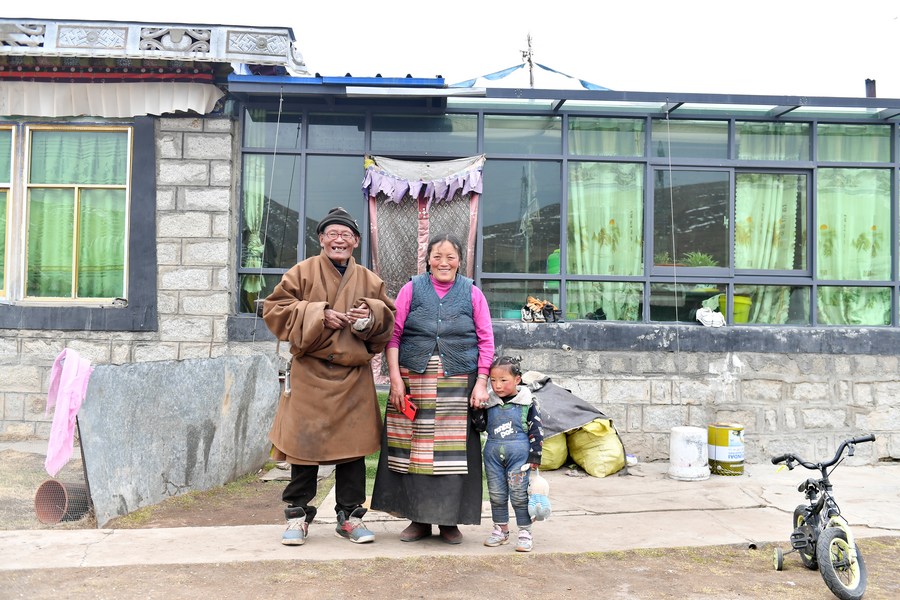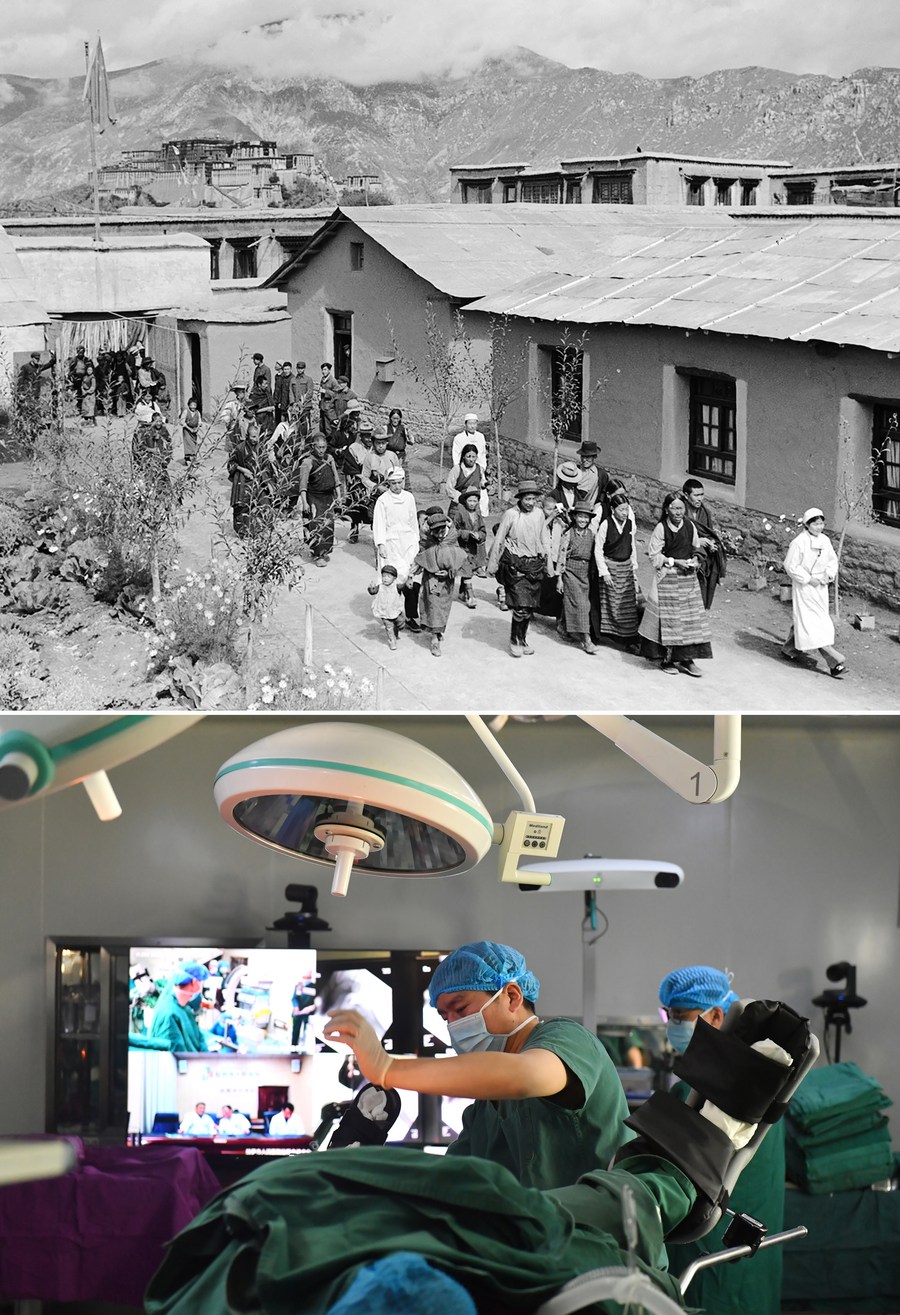Retracing Tibet's rise to stability and prosperity

A grand gathering is held to celebrate the 70th anniversary of the peaceful liberation of Tibet at the Potala Palace square in Lhasa, southwest China's Tibet Autonomous Region, Aug. 19, 2021. (Xinhua/Sun Ruibo)
LHASA, Dec. 14 (Xinhua) -- For Tibet, 2021 has certainly been an important year.
The autonomous region in southwest China marked the 70th anniversary of its peaceful liberation, celebrated the 100th founding anniversary of the Communist Party of China (CPC) along with the rest of the country, and held a regional CPC congress, a five-yearly event.
The region has achieved remarkable feats over the past decades. Since its peaceful liberation in 1951, Tibet has embarked on a path from darkness to brilliance, from backwardness to progress, from poverty to prosperity, from autocracy to democracy, and from isolation to openness.
History can serve as a valuable prism for retrospection. It is, therefore, worthwhile to explore some of the major reasons behind the profound changes the region has undergone over the past years.
STRONG PARTY LEADERSHIP
"Without the CPC, there would not be New China and there would not be new Tibet," said Wang Yang, a member of the Standing Committee of the Political Bureau of the CPC Central Committee and chairman of the National Committee of the Chinese People's Political Consultative Conference.
Only by following the CPC leadership and pursuing the path of socialism, can Tibet achieve development and prosperity, he said in August while addressing a grand gathering marking the 70th anniversary of the peaceful liberation of Tibet.

Pigeons fly over the sky during a grand gathering to celebrate the 70th anniversary of the peaceful liberation of Tibet at the Potala Palace square in Lhasa, southwest China's Tibet Autonomous Region, Aug. 19, 2021.(Xinhua/Zhai Jianlan)
Under the strong leadership of the Party, the region has resolved many long-standing problems and achieved all-round progress in all endeavors since the peaceful liberation, which marked a historic transition of epoch-making significance for Tibet.
Tibet carried out the democratic reform in 1959 to abolish feudal serfdom, established the socialist system and implemented regional ethnic autonomy, and pressed ahead with reform and opening up as well as modernization.
Soinam Doje, hailing from a village in Damxung County in the regional capital Lhasa, witnessed the arrival of the People's Liberation Army in 1951.
"I never expected life would become this good. I thought it would be great if the soldiers could arrest the thieves and robbers back then, as yaks and sheep were often stolen or robbed," said Soinam Doje, 82.
Soinam Doje used to be a serf who had to pay heavy taxes to his feudal lords and barely had enough food to fill his stomach. After the democratic reform in 1959, he was allocated with his own livestock and grassland.
The village cooperative now offers his family dividend from the gypsum mine business. Besides, his eldest son has bought a truck and an excavator, and drives them for the mine. Together with the family's income generated from herding, they bring home as much as 500,000 yuan (about 78,500 U.S. dollars) a year.

Soinam Doje and his family pose for a photo at home in Nalung Village of Wumatang Township in Damxung County of Lhasa, capital of southwest China's Tibet Autonomous Region, April 15, 2021.(Xinhua/Sun Ruibo)
Tibet's regional GDP soared from 129 million yuan in 1951 to more than 190 billion yuan last year. The per capita disposable income of rural residents in the region was 14,598 yuan in 2020, registering double-digit growth for the past 18 years, while that of urban residents was 41,156 yuan.
The region's average life expectancy has increased from 35.5 years in 1951 to 72.19 years at present.
Wang Junzheng, the Party chief of Tibet, said at the 10th regional CPC congress late last month that the strong leadership of the CPC Central Committee was the most important reason behind Tibet's achievements over the past five years.
GUIDELINES FOR GOVERNING TIBET
Over the past 70 years, hunger and poverty have become a thing of the past, religious beliefs have been fully respected, and national unity and social stability have been safeguarded.
To serve people of all ethnic groups in Tibet, the CPC put great emphasis on Tibet work, introducing a raft of favorable policies. The Party's guidelines for governing Tibet were also formed, which has been a pillar for Tibet's progress and prosperity.
"The CPC's guidelines for governing Tibet have ensured the right direction of the region's development and produced bountiful results," said Li Huiqin, a professor at Shaanxi-based Xizang Minzu University.
Based on a keen understanding of new situations at home and abroad, the CPC has summarized its successes in leading the people of Tibet to stability and prosperity, and proposed the guidelines for governing Tibet in the new era.
The guidelines include upholding CPC leadership, socialism with Chinese characteristics, and the system of regional ethnic autonomy; upholding the strategy on governing border areas and ensuring stability in Tibet; safeguarding national unification and strengthening ethnic unity; and prioritizing ecological protection.
"These new guidelines have forged the future direction for Tibet work and boosted confidence for pushing ahead such work," said Li Hongjun, deputy secretary-general of the regional government.
Wang Junzheng said the guidelines for governing Tibet in the new era must be implemented thoroughly while pursuing new achievements in regional development.
ASSISTANCE FROM WHOLE COUNTRY
The region's past achievements were the results of the firm leadership of the CPC Central Committee, the hard work of officials and people of all ethnic groups in Tibet, as well as the tremendous support given by people across the country.
The CPC Central Committee made a major decision on the pairing-up assistance by the whole country during the third central symposium on Tibet work in 1994.
Under the mechanism, provincial-level regions, central government departments and centrally administered state-owned enterprises have injected 52.7 billion yuan into Tibet through 6,330 projects between 1994 and 2020. They also selected and dispatched 9,682 cadres to the region.

In this combo photo, the upper part taken by Ren Yongzhao shows patients walking to the doctors' offices at Lhasa People's Hospital in the 1950s; and the lower part taken by Sun Ruibo on April 19, 2021 shows surgeons of Lhasa People's Hospital using a robot to perform an orthopaedic surgery under the remote guidance of experts from Beijing Jishuitan Hospital through 5G communication technology in Lhasa, southwest China's Tibet Autonomous Region. (Xinhua)
Ngari Prefecture, known for its high altitude of more than 4,500 meters on the average and harsh natural environment, saw the opening of a neonatal critical care center last month, the first of its kind in the prefecture.
Built with a total investment of 5 million yuan, the center established in Ngari Prefecture People's Hospital is the result of joint efforts of a pairing-up aid program from Shaanxi Province along with the Beijing United Charity Foundation.
"The center is equipped with high-frequency oscillatory ventilation equipment and will be used for the treatment of acute respiratory distress syndrome, pulmonary hemorrhage and other refractory respiratory failures," said Chen Chen, head of the hospital and also a member of the Tibet-aid team from Shaanxi.
The support for Tibet from the whole country shows the advantage of socialism to solve major problems by pooling resources from across the nation, said Xu Xing, a professor at Tianjin-based Nankai University.
"Only China and the CPC can accomplish something like this in the world, demonstrating our political and institutional advantages," Xu said.
Photos
Related Stories
Copyright © 2021 People's Daily Online. All Rights Reserved.










